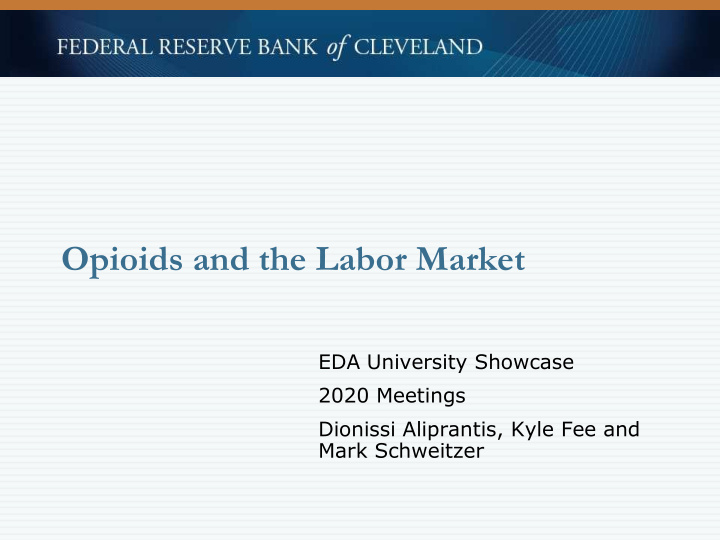



Opioids and the Labor Market EDA University Showcase 2020 Meetings Dionissi Aliprantis, Kyle Fee and Mark Schweitzer
Disclaimer These are my views and not necessarily those of the Federal Reserve Bank of Cleveland or the Federal Reserve System.
Why is this a Cleveland Fed Issue? Source: Center’s for Disease Control
Key Pieces of the Research Literature Case and Deaton , 2015 show that poor labor market prospects of low education groups is associated with an increase in overdose deaths, suicides, and liver disease or “Deaths of Despair” Krueger , 2018, shows that opioid availability helps to explain poor prime- age labor market participation rates in the 2000s Currie, Jin, and Schnell ,2018, find a positive opioid effects on employment to population rates for prime age women (and to a lesser degree for men) Harris, Kessler, Murray, and Glenn , 2019, used Prescription Drug Monitoring Program data show that opioid prescriptions cause labor force participation rates to be lower in 10 states
Our Approach to this Issue Examine the geographic relationship from 2006- 2016 between Opioid Employment/Population Prescriptions and Participation Rate Unemployment There are a lot of other things that could matter: Age, sex, and education levels of population A really large recession and gradual recovery Bad local labor markets Economically challenged regions
Key Data Sources • Centers for Disease Control and Prevention (CDC) Rx Data Annual data from 2006-2016 County-level identifier Sample is 59,000 retail (non-hospital) pharmacies - Covers 90 percent of counties - Covers 90 percent of all retail Rx’s in US - Impute missing Rx data using PUMA-level average
Key Data Sources American Community Survey (ACS) - 1% sample of the 1-year ACS from 2006-2016 - Integrated Public Use Microdata Series (IPUMS-USA) - N > 15 million - Individual-level labor market outcomes and demographics COUMA geographic identifier - County identifier if pop 100k - PUMA identifier if county pop 100k 1/3 of US population in a non-identified county
The Recession and Local Demand Matter
Linear Probability Models
Controls for Local Economic Conditions
Vary the Level of the Location Fixed Effects
Demographic Differences are Large
Do Economic Conditions Increase Opioid Use? • What about the other direction – the labor market causing opioid use? • The Great Recession was a major shock to the labor market. If the labor market drives opioid use, we should see an increase in use whose timing coincides with the Great Recession • Maybe opioid use just occurs where labor markets are bad. Labor market weakness is persistent in many place, so if that determines it should be the case that more troubled places are more impacted
Are Persistently Bad (Good) Labor Markets Driving our Results? There are poor labor markets with both high and low prescriptions rates.
Regression Coefficients by Quintile of 2000 LFPR 21 Source: Aliprantis, Fee and Schweitzer (2019)
Implied National Impacts are Really Large Using our estimates and historical data on national numbers of prescriptions, we can estimate the national impact since 2001.
Opioids and the Labor Market • Opioid prescriptions are associated with lower employment and participation rates • Effects are largest for men with high school or less educations: white and minority • Effects are generally smaller for women • The Great Recession does not appear to have boosted use • Bad labor markets do not appear to be more susceptible to opioid prescriptions • We estimate a large (model dependent) fraction of the realized decline in prime age labor force participation rate
Recommend
More recommend